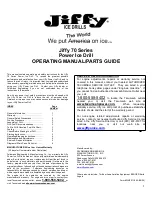
5
FUNCTIONAL DESCRIPTION
CAUTION:
•
Always be sure that the tool is switched off and the
battery cartridge is removed before adjusting or
checking function on the tool.
Installing or removing battery cartridge
Fig.1
•
Always switch off the tool before installing or
removing of the battery cartridge.
•
To remove the battery cartridge, slide it from the
tool while sliding the button on the front of the
cartridge.
•
To install the battery cartridge, align the tongue on
the battery cartridge with the groove in the housing
and slip it into place. Always insert it all the way
until it locks in place with a little click. If you can
see the red indicator on the upper side of the
button, it is not locked completely. Install it fully
until the red indicator cannot be seen. If not, it may
accidentally fall out of the tool, causing injury to
you or someone around you.
•
Do not use force when installing the battery
cartridge. If the cartridge does not slide in easily, it
is not being inserted correctly.
Battery protection system
The battery cartridge is equipped with the protection
system, which automatically cuts off the output power for
its long service life.
The tool stops during operation when the tool and/or
battery are placed under the following situation. This is
caused by the activation of protection system and does
not show the tool trouble.
•
When the tool is overloaded:
At this time, release the switch trigger,
remove the battery cartridge and remove
causes of overload and then pull the switch
trigger again to restart.
•
When battery cells get hot:
If any operation of the switch trigger, the
motor will remain stopped. At this time, stop
use of the tool and cool the battery cartridge.
•
When the remaining battery capacity gets low:
If you pull the switch trigger, the motor runs
again but stops soon. In this case, to prevent
over discharge, remove the battery cartridge
from the tool and charge it
Switch action
Fig.2
CAUTION:
•
Before inserting the battery cartridge into the tool,
always check to see that the switch trigger
actuates properly and returns to the "OFF" position
when released.
To start the tool, simply pull the switch trigger. Tool
speed is increased by increasing pressure on the switch
trigger. Release the switch trigger to stop.
Reversing switch action
Fig.3
This tool has a reversing switch to change the direction
of rotation. Depress the reversing switch lever from the A
side for clockwise rotation or from the B side for
counterclockwise rotation.
When the reversing switch lever is in the neutral position,
the switch trigger cannot be pulled.
CAUTION:
•
Always check the direction of rotation before
operation.
•
Use the reversing switch only after the tool comes
to a complete stop. Changing the direction of
rotation before the tool stops may damage the tool.
•
When not operating the tool, always set the
reversing switch lever to the neutral position.
Speed change
Fig.4
To change the speed, first switch off the tool and then
slide the speed change lever to the "2" side for high
speed or "1" side for low speed. Be sure that the speed
change lever is set to the correct position before
operation. Use the right speed for your job.
CAUTION:
•
Always set the speed change lever fully to the
correct position. If you operate the tool with the
speed change lever positioned halfway between
the "1" side and "2" side, the tool may be
damaged.
•
Do not use the speed change lever while the tool is
running. The tool may be damaged.
Adjusting the fastening torque
Fig.5
The fastening torque can be adjusted in 17 steps by
turning the adjusting ring so that its graduations are
aligned with the pointer on the tool body. The fastening
torque is minimum when the number 1 is aligned with
the pointer, and maximum when the
marking is
aligned with the pointer.
The clutch will slip at various torque levels when set at
the number 1 to 16. The clutch is designed not to slip at
the
marking.
Before actual operation, drive a trial screw into your
material or a piece of duplicate material to determine
which torque level is required for a particular application.






































